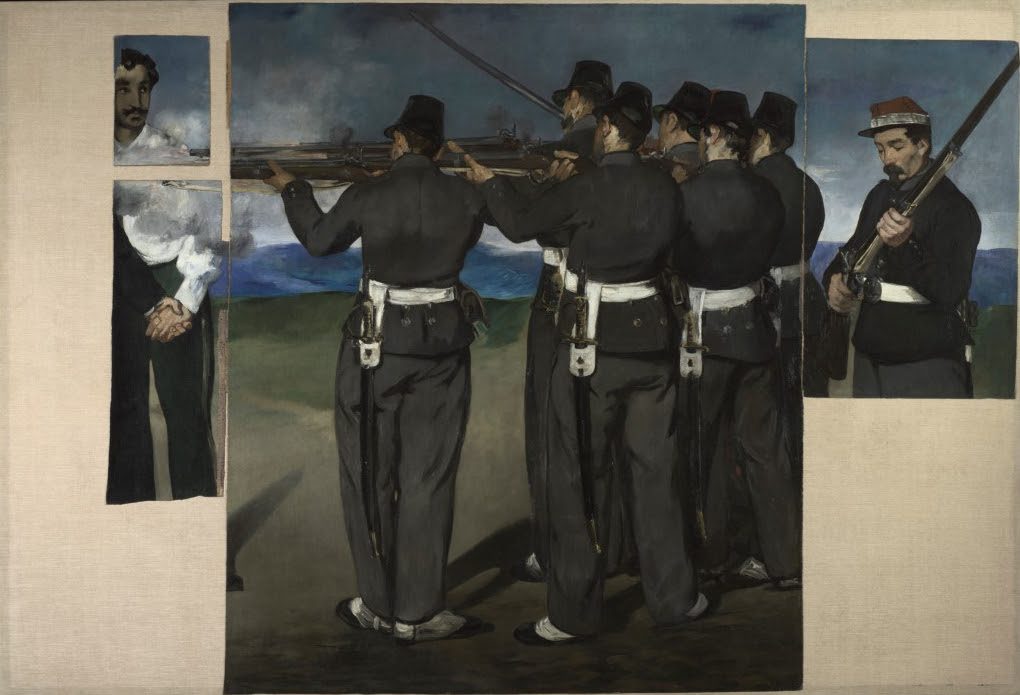Mead Gallery “Unreliable Evidence” – Review
As part of the National Gallery Masterpiece Tour, the Mead Gallery’s latest exhibition Unreliable Evidence welcomes Edouard Manet’s infamous piece, “The Execution of Maximilian” (1867-8). Depicting the assassination of Emperor Maximillian of Mexico, where he was shot alongside two of his generals Mejia and Miramon, the painting proves to be no ordinary account of tumultuous histories. Encapsulating the title of the exhibition itself, the fragmented history of the painting has left us without its left-hand section and therefore only the partial image of Maximilian’s hand clasping that of Miramon’s. Physically depicting the way an individual of such esteem has been torn down by war and devoid of an identity. Similarly to Manet when painting the scarcely reported events of Querétaro; we too are left to our own imaginations and interpretations.
The interlinking nature between Manet’s centrepiece and the other exhibited artworks force us to question how the past is represented and brings to light the individual lost histories that form the incomprehensible narratives of nations affected by conflict. Throughout all of the artworks, varying in mediums and discussion, each artist omits enough information for their pieces to be viewed entirely subjectively. Unreliable Evidence is not concerned with reporting histories in a factual sense, but instead recording and reclaiming individual struggles.
Spanish artist Santiago Sierra delves into the collective identity of the soldier in his collection of six digital prints War Veterans Facing the Corner, (2011 – ongoing). The veterans of wars of Afghanistan, Iraq, Cambodia, Rwanda, Bosnia and Kosovo mirror that of the six members of Maximilian’s firing squad, showing us the interchangeable nature of these men’s roles in society – being both at once the perpetrator and the victim. Through their faceless portrayal, both Manet and Sierra depict the diminished identities of soldiers. They are merely tools of power manipulated by the political motivations of their governments. Sierra’s life size prints are not hung, but simply propped in inconspicuous corners serving to unnerve us in its blatant objectification.
Luc Tuyman’s inclusion in Unreliable Evidence is also no coincidence, tying both his and Manet’s protagonists in their controversial deaths. Through his distortions of media images in distinctive figurative paintings, he examines the notions of history and colonial memory within Belgium’s ruling of Congo. His focus on the 1961 execution of the first democratically elected president Patrice Emery Lumamba maintains a social commentary of “everyman for themselves”, similarly to France and Napoleon’s abandonment of Maximilian, the United Nations neglected to provide Lumamba with aid. The identities of these men, Maximilian, Lumamba and veterans alike are whittled down to be nothing more than pawns of capitalist hierarchy.
The exhibition not only explores men directly involved in combat but also offers the experiences of ordinary people whose cities were left ravaged by war. In the forms of video installation and photography, Mexican Edouard Aragon and Ugandan Zarina Bhimji both depict their own respective countries struggle. Despite the difference in mediums, both artists leave us with an image of brutal absence. The post-apocalyptic quality of Bhimji’s Your Sadness is Drunk (2001-6) proves more striking than the more predictable image of guns in lllegal Sleep (2007), as human activity has been interrupted and abandoned leaving only chickens and a washing line as the remnants of society.
In Family Effects (2007-2009), Aragon paradoxically infuses children’s games with cinematic stereotypes of mob culture to depict Oaxaca’s deep rooted culture of crime and corruption. The sheer silence in the clips of pseudo violence is disturbing and highlights the way war can penetrate and transcend generations. It is the silence that both artists convey and really shows us the extent to which homes, communities and morals have been reduced.
Throughout the exhibition we are met with questionable accounts both factual and constructed and the works of Omer Fast, Rabih Mroué, Hito Steyerl only serve to reinforce our doubts of what is true. The artists’ mystifying approach follow suit of Manet’s example, leaving many questions of the context and meaning of art unresolved. However, what is unmistakable is the exhibition’s reclamation of lost identity. Despite individuals and their nations falling victim to the wider social and political construct of war, through the exploration of their turbulent histories they are in turn empowered and heightened over their oppressors.

Comments (1)